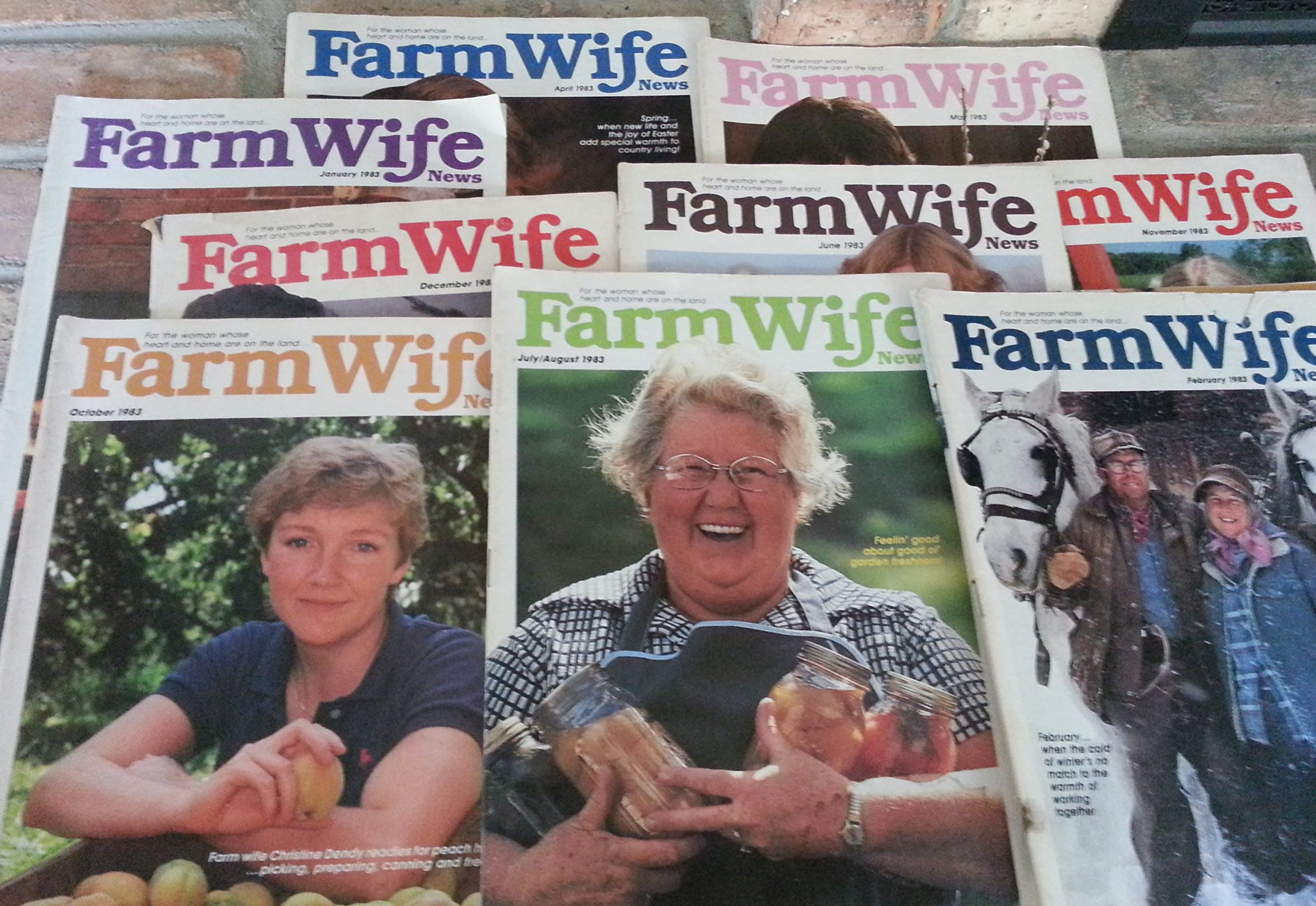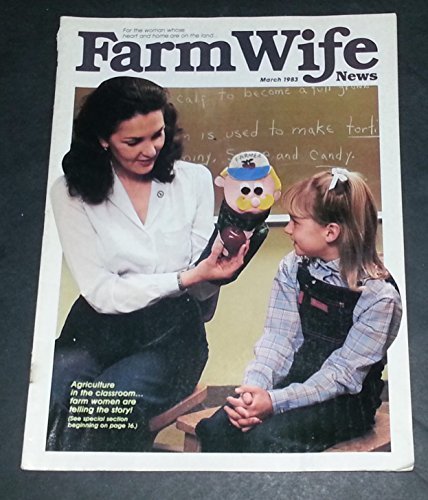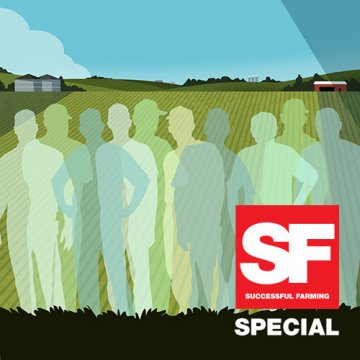Farm Women in Crisis Times: Rethinking Women’s Roles in the 1980s
Pamela Riney-Kehrberg, Department of History, Iowa State University
Editor’s Note: In today’s post, Pamela Riney-Kehrberg highlights the research she presented at last month’s Rural Women’s Studies Association conference on gender roles during the 1980s Farm Crisis. Successful Farming magazine recently published an article comparing farm suicide rates from the 1980s (which Riney-Kehrberg discusses below) to those of today.
The Farm Crisis of the 1980s was a time of upheaval in American agriculture, second only to the long depression of 1920-1940. The crisis affected many different facets of farm life, including farm women’s roles. While farm women had traditionally cast themselves as “helpers” in the family enterprise, what helping meant took on increased meaning in the face of economic disaster. In this paper, I examine the ways in which two different farm publications pitched their discussions of farm women’s roles throughout the 1980s. These rather divergent farm publications, Successful Farming and Farm Wife News, had remarkably similar takes on the ways in which farm women could support the family enterprise. They explored women’s activities on four different fronts: an increased productive and managerial role on the farm, participation in activism, increased work off the farm, and greater attention to mental health. Two of these, increased roles on the farm and participation in activism, were bolstered by years of experience, and could be presented as relatively non-controversial. On the other hand, women’s off-farm work and attention to mental health were considerably more fraught, because of their close association with shame. Farm women following these paths would be exposing their families’ weaknesses, and making visible burdens that normally were not spoken of in public.

By the 1980s, certain understandings of farm women’s roles and work seemed well established, and received treatment as such in these two publications. First, women’s roles as producers and as managers were both accepted and celebrated. Every issue of Farm Wife News began with the editor visiting and working with a farm woman, and participating in some sort of production agriculture, be it goat raising or corn harvesting. Successful Farming, on the other hand, spent the vast majority of its time with men as producers, but in November of 1978 ran a large special section entitled “Womanagement,” detailing the many ways women were integral to the farm team. They highlighted farms on which women were full partners and where they worked as full time farm managers, and also discussed the importance of paying salaries to women who worked in the family business. Salaries would acknowledge their hard work, AND save money on taxes. Within the pages of Successful Farming was also acknowledgement that women performed some farm tasks better than men, such as caring for young pigs and calves, largely due to their attention to detail and greater patience. By 1979, the University of Missouri had begun what they titled a “Feminine Farrowing School,” and 260 women applied for 33 places.[1]
Another area that went without much explanation, but lots of simple acknowledgement, was women’s role in farm advocacy. As Jenny Barker Devine so eloquently argued in her book, On Behalf of the Family Farm, farm women’s advocacy for agriculture began well before the crisis of the 1980s, and farm women often justified their activities through their commitment to the preservation of their family farm.[2] In these publications from the 1980s, that justification appeared as a given. Of course it was a farm woman’s place to speak out on behalf of the needs of farmers. A 1980 feature in Farm Wife News featured the motherly, and grandmotherly, faces of mainline farm women’s advocacy, in the form of Nita Gibson, from Women in Farm Economics, Evelyn Landis of American Agri-Women, and Lois Gross of the American Farm Bureau Women.[3] At decade’s end, Successful Farming celebrated the activities of Sister Thomas More Bertels, “agriculture’s hell-raising nun,” who in addition to advocating for farms taught history at Silver Lake College in Manitowoc, Wisconsin. As she commented, “I really don’t raise hell . . . but I talk directly and call a spade a spade.”[4] Both publications announced meetings of women’s farm groups, and encouraged attendance. They featured stories about farm woman activists, including those working in areas such as nuclear non-proliferation. Interestingly, while the publications covered more grass roots protests, such as farmers holding crosses on courthouse lawns, they did not encourage farm women to join them. This was skirting close to areas where many farm people were less comfortable. When, in 1978, Successful Farming had lauded women’s work with the Farm Bureau, WIFE, and other organizations, they praised them for “raising responsible hell.”[5]

Both Successful Farming and Farm Wife News attempted to normalize the idea of women taking off-farm employment, but here they were running up against the problem of shame in two different ways. As Deborah Fink discussed in Open Country, Iowa, farm women often balked at the idea of moving outside of the family circle to work. In many communities, this was a less than respectable path for a woman to take, and involved taking low wage, low skill work.[6] In the midst of an economic crisis, it took on another potential taint, airing dirty laundry. If a farm woman had never worked off the farm previously, and suddenly sought employment in town, it was practically an open admission that not all was well on the farm. Additionally, it could create stresses between husband and wife, and cause upheaval for a family’s children.
For women entering the job market, Successful Farming provided regular features detailing the problems that might arise, and explaining how careful planning and family cooperation could overcome them. Cheryl Tevis, who in the 1980s edited women’s issues for Successful Farming, suggested to her readers that teamwork was essential to a successful transition, and that women might have to lower their housekeeping standards in order to retain their sanity.[7] This was increasingly important advice for farm families. By decade’s end, farm families nationwide generated more than half of their total income off the farm. Many farm families, and farm men in particular, believed, however, that this was a stop-gap measure. As Larry Black of Mount Pleasant, Iowa, commented in reply to a 1989 survey, “An off-farm job is fine to see a family through a bad crop year, but I don’t believe in trying to save the farm through off-farm income. I think the farm should pay for itself.” In hard times, however, this was a tenuous proposition.[8]
Even more tenuous was the push to get farm families to acknowledge pain and loss – to go beyond their reticence, in search of better mental health. Getting farm people to accept help in the face of crisis could be a difficult task. Cheryl Tevis spoke about the mental health problems that hard times brought, and the shame surrounding them. Many individuals who were in need of help, she commented, refused to seek it because someone might see them parked outside a mental health clinic in town.[9] As an alternative, both Farm Wife News and Successful Farming took the mental health message to their readers in print, to be read in the privacy of the home. Farm Wife News hired South Dakota therapist Val Farmer to write a regular column of mental health advice, and Successful Farming enlisted counselors Donald J. Jonovic and Wayne D. Messick, from Ohio, to write a monthly column, “Can Their Problem be Solved?” Their column took actual problems farm people, usually women, had written to them about, and developed them into a constructive discussion about conflict resolution. Farmer’s column covered a variety of topics from the non-controversial, such as networking and how to argue constructively, to the far more difficult, such as “ending the hurt and danger of violent relationships,” in which he encouraged farm women to leave their abusive spouses.[10]

Farm Wife News largely confined its mental health discussions to Farmer’s regular column, but Successful Farming, interestingly enough, took its efforts further. As early as 1979, Cheryl Tevis was writing about stress on farms, asking the question, “Where does SHE go to let off steam?” She touted a peer counseling program developed at the University of Wisconsin-Stout, called Women Helping Women.[11] In 1980, she cast a broader net, writing for both men and women, encouraging farm families to talk about their problems without fear. Lest farm people assume that they were stronger emotionally than their city cousins, Successful Farming also reported on the higher levels of depression in rural areas, and the fact that sexual abuse of children happened on farms, too. By 1982, the magazine was publishing an eight page spread on stress; in 1983, a four page article on alcoholism among farmers; and in 1984 a two page article on depression. It’s unclear who the editors thought would be reading this material, but it’s more than likely that farm women were the primary consumers, who then applied the information and suggestions to their home situations. As a side note, they certainly left the writing about these issues to a woman editor! Apparently, taking care of the mental health of families was as much a woman’s job as cooking the meals and caring for the children. The farm publications operated in much the same way as Extension did throughout this period, providing do-it-yourself suggestions on how to help farm families too proud, or too paralyzed, to walk themselves into a counselor’s office.[12]
The conditions of the 1980s forced farm women to look at their lives, their work, and their family relationships in new ways. These were not years that supported business as usual, and women who clung desperately to business as usual had the potential for great disappointment. Those writing for and advising women in agriculture encouraged them to think creatively and to embrace new roles as they arose. Predictably, there were those who balked. In 1984, a 48 year old Minnesota farm woman was quoted in the New York Times as saying “I want my husband to be superior because if a storm is coming, I want him to tell me when to get down in the basement.” Cheryl Tevis, ruminating on this comment and the concerns of the many farm women she knew had a rejoinder: “What if he’s not around sometime when the wind blows?” The wind was blowing, and farm women needed to strengthen their homes, families, and lives against the storm.[13]
Notes
[1] “Womanagement” insert, Successful Farming Magazine, November 1978; “A woman’s place: In the (farrowing) house?” Successful Farming Magazine, January 1979, H36; “Let a woman do it,” Successful Farming Magazine, August 1980.
[2] See Jenny Barker Devine, On Behalf of the Family Farm: Iowa Farm Women’s Activism since 1945 (Iowa City: University of Iowa Press, 2013), 1-14.
[3] Ann Kaiser, “Farm Women Leaders Talk Out on Priorities for U.S. Agriculture,” Farm Wife News, August 1980, 16-17, 33.
[4] Jeanice Midgett, “Agriculture’s hell-raising nun,” Successful Farming Magazine, August 1989, “Successful Country Living” supplement.
[5] Gary Vincent, “The New Activists: Raising responsible hell,” Successful Farming Magazine, Womanagement insert, November 1978.
[6] Deborah Fink, Open Country, Iowa: Rural Women, Tradition and Change (Albany: State University of New York Press, 1986), 195-197.
[7] Cheryl Tevis, “Should Mom join the job market?” Successful Farming Magazine, November 1981, 36-37-x; Cheryl Tevis, “How off-farm work alters family life,” Successful Farming Magazine, May 1986, 19.
[8] “What Farmers Are Saying,” Successful Farming Magazine, Mid-March 1989, 56.
[9] Cheryl Tevis, interview with author, April 19, 2018.
[10] Val Farmer, “Ending the Hurt and Danger of Violent Relationships,” Farm Woman News, November 1985, 20.
[11] Cheryl Tevis, “Where does SHE go to let off steam?” Successful Farming Magazine, October 1979, 22-23.
[12] Cheryl Tevis, “Stress,” Successful Farming Magazine, October 1980, 20-21; Cheryl Tevis, “Stress,” Successful Farming Magazine, February 1982, 27-42; Gary Vincent, “`My husband is being treated for alcoholism,” Successful Farming Magazine , October 1983, 20-23; Owen Taylor, “Mental depression higher in country than city,” Successful Farming Magazine, June 1985; Cheryl Tevis, “Joint Venture: Child molesting happens on the farm, too,” Successful Farming Magazine, March 1985, 10-H; Cheryl Tevis, “Depression: Growing occupational hazard for farmers,” Successful Farming Magazine, January 1984, 30-31.”
[13] Cheryl Tevis, “Woman Interest,” Successful Farming Magazine, February 1984, 28-C.
